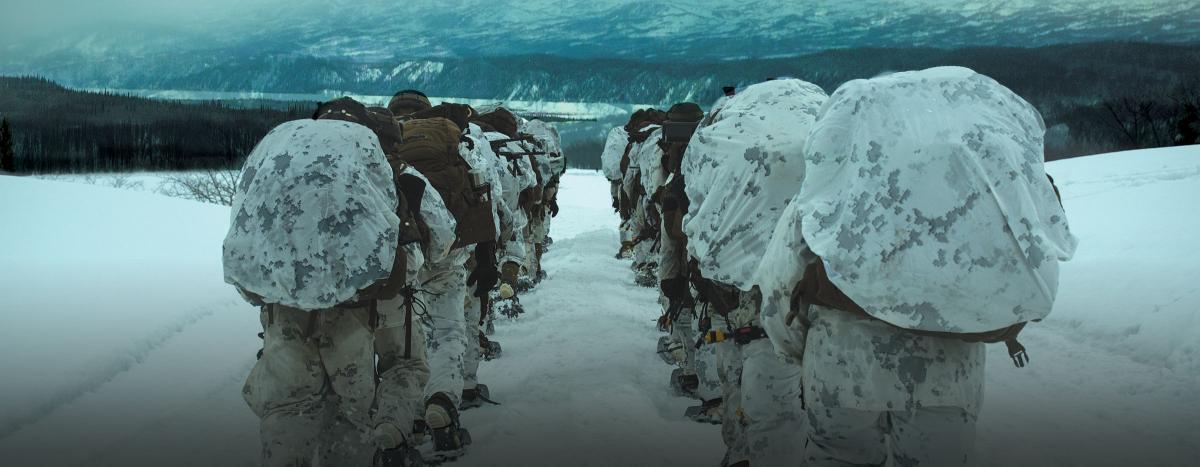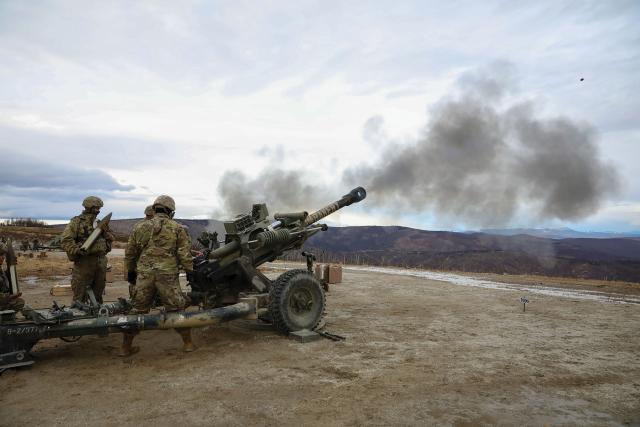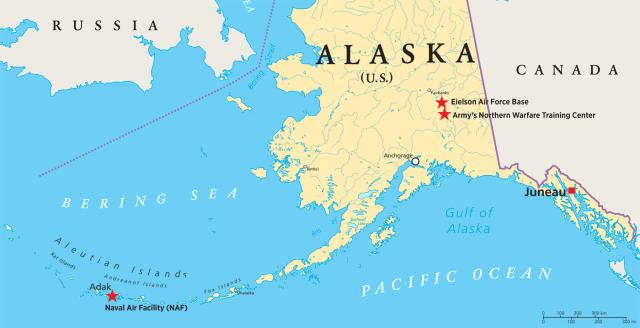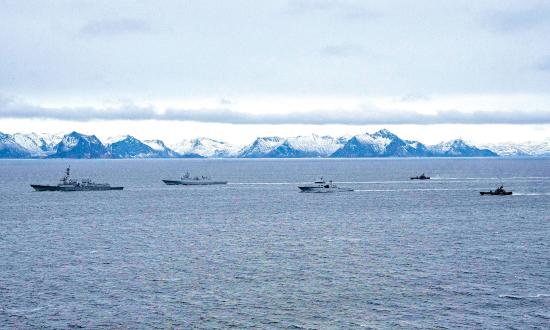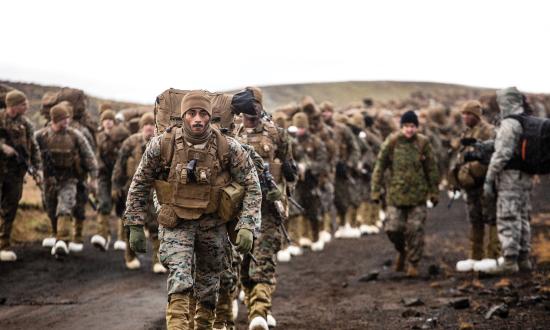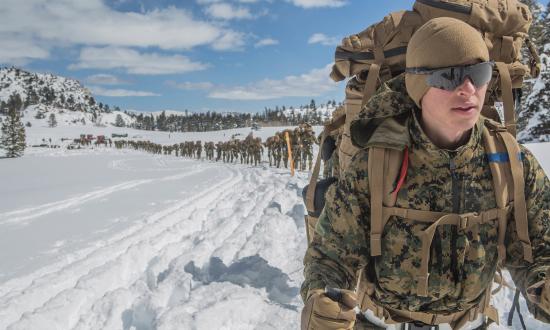While some defense pundits push narratives of a seemingly inevitable conflict in the South Pacific, the United States is quietly changing the way it postures for future operations in the Arctic. Is this a moot contingency or a strategic shift to great power competition across the last frontier? The 2017 National Security Strategy and multiple service-level initiatives suggest the latter. With record sea ice melt and the forging of unprecedented trade routes in the region, freedom of navigation and securing global commerce will be critical.1 And the discovery of natural resources appraised in the trillions—most notably, an estimated 13 percent of the global oil reserves and 30 percent of natural gas—will lend itself to immense resource competition among the world’s most powerful nations.2 The United States cannot afford to leave the global commons of the Arctic unprotected.
The Army and Air Force both have robust Alaskan bases, providing the nation invaluable training venues, forward warning, and deterrence against Russian and Chinese advance in the Bering and Arctic Seas. In contrast, the Marine Corps lacks a permanent installation in the Arctic and thus can appear uncommitted to operations in the region. With no permanent infrastructure or regular rotational Alaskan deployments, the service is ill equipped and trained to operate in the maritime Arctic environment. The Marine Corps must take decisive action to address this deficiency and make itself relevant in this strategically pivotal space.
Were it to develop both a joint Navy–Marine Corps amphibious base on Adak Island and an Army–Marine Corps warfare training center at Fort Wainwright, Alaska, the Marine Corps would be better postured for future Arctic operations and could more effectively prepare its forces for conflict in any clime and place.
Train the Way You Fight?
For a force whose training should be “focused on winning in combat in the most challenging conditions and operating environments,” Marine expeditionary units (MEUs) and amphibious ready groups (ARGs) exercise in some of the most permissive weather conditions on the planet.3 I Marine Expeditionary Force (I MEF), for example, home to the Pacific Command–aligned formations, trains and certifies its units at a handful of areas at Camp Pendleton and on San Clemente Island, some 40 miles off the Southern California coast. At just 56 square miles, San Clemente Island can accommodate amphibious landing operations at a single location, greatly hindering a MEU’s ability to exercise flexibility or creativity. The island’s weather and sea states are generally “vacationesque,” with an average annual temperature in the low 70s and 263 days of sun per year. Future operating environments might not be as permissive.
In the Arctic, competition will center on key terrain and its ability to influence and support sea control operations. Employing expeditionary advanced bases to extend sphere of influence and enhance sustainability will be paramount, but environmental conditions could drive what is possible. Arctic conditions cannot be simulated in sunny California or tropical Hawaii. The ability to not only survive, but also compete in the harshest environmental conditions imaginable requires deliberate training, tailored equipment, institutional knowledge, and experience.
If the Marine Corps wants to “train the way we expect and intend to fight,” it must make drastic changes to where and how it prepares its premier amphibious force in readiness.4
Reopen Adak
To reconcile shortfalls in I MEF’s training venues while also “facilitating [Arctic] sea control and sea denial operations,” the Marine Corps and Navy should reopen Naval Air Facility (NAF) Adak Island as an amphibious training site.5 An important foothold during World War II and the Cold War, the base was instrumental in detecting Soviet air, surface, and subsurface forces traveling through the Bering and Arctic Seas. Because the island is located farther west than Hawaii, the base was a powerful deterrent in the Pacific maritime theater, as well. These are roles NAF Adak can and should resume today.
In contrast to San Clemente Island, Adak offers dozens of potential beach landing sites, 275 square miles of viable training areas, a deep-water port, and a 7,800-foot runway. These features make it uniquely suited for training every aspect of the Marine air-ground task force (MAGTF). Adak is one of 14 large volcanic islands in the Aleutians, which in conjunction with another 55 smaller islands, form an 1,100-mile chain to the mainland. This archipelago provides a venue to exercise expeditionary advanced base operations in contested littorals similar to what Marine Corps forces could expect to encounter in the South Pacific. Reactivation of NAF Adak as a joint Navy–Marine Corps amphibious base would help ensure the demands of the National Security Strategy are met in both the Arctic and Pacific.
Of course, refurbishing NAF Adak would not be cheap. Former Secretary of the Navy Richard Spencer and other Navy leaders have estimated restarting operations at Adak could cost taxpayers $1.3 billion.As an alternative, the services could deploy to existing Arctic staging locations, such as the Marine deployments to Norway, on a rotational basis, or they could return “P-8A Poseidons to Keflavik in Iceland [to patrol] over the waters around Greenland, Iceland, and the UK.”6 These options would provide short-term savings, but they would not address the long-term consequences of allowing the Bering Strait and Sea to become increasingly destabilized by Russian and Chinese expansion. In addition, unlike European Arctic deployments, Adak Island provides both an immediate presence in the subarctic maritime domain and deterrence in the Pacific theater.
Relocate Mountain Warfare Training
The Marine Corps Mountain Warfare Training Center (MCMWTC) in Bridgeport, California, is the service’s foremost mountaineering and cold-weather training center. Unlike Camp Pendleton and San Clemente Island, MCMWTC is located on permitted land within the Humboldt-Toiyabe National Forest. Because of civil-military co-use agreements and environmental restrictions, live-fire training on the installation is limited. Environmental restrictions also prohibit practicing many of the skills necessary to fight in cold-weather conditions, such as survival fires, hunting, and foraging. This is detrimental to the service’s ability to provide realistic training.
As the Marine Corps transitions to using MCMWTC for service-level training exercises rather than mountaineering-specific skills, its suitability for MAGTF-level operations should be scrutinized. Marine Corps Commandant General David Berger has noted, “We must be able to say with confidence that the $5.5 million we expend per [integrated training exercise] rotation is causing greater readiness and, therefore, providing a return to the service for the investment.”7 Given the limited ability to exercise live-fire training, air integration, off-road mechanized and motorized operations, and unmanned aerial system employment at MCMWTC, the return on that investment is increasingly difficult to justify. A new installation that facilitates both cold-weather mountaineering and MAGTF-level operations is needed.
Relocating MCMWTC with the Army’s Northern Warfare Training Center at Forts Greeley and Wainwright and Black Rapids, Alaska, would greatly enhance joint service interoperability, improve the Marine Corps’ cold-weather and mountaineering training, facilitate MAGTF-level operations in support of service-level training exercises, and position the service on the Arctic front. When comparing training opportunities at MCMWTC with those in Alaska, it is important to note that Alaska “already hosts the largest aerial training ranges in the United States and hosts major [joint] exercises.”8 In an interview pertaining to Marines training in Alaska, General Berger explained, “You got the dual advantage of huge airspace and a huge sea space. You can stretch muscles of a joint force in Alaska in a way that’s difficult to do anywhere else!”9
In addition, the training center would be collocated with Eielson Air Force Base, home of the 345th Fighter Squadron and the Air Force’s newest F-35 squadron, reinforcing the Marine Corps’ dedication to joint operations. While MCMWTC is limited to force-on-force training with blank simulation rounds, Alaskan service-level training exercises could include both ground and aerial live-fire training, as well as joint service support. If the Marine Corps wants to “fully embrace our role as a critical enabler to the Joint Force,” moving MCMWTC to the Army’s Northern Warfare Training Center is an important step—in both developing joint interoperability and addressing current shortfalls in its service-level training exercise program.10
Although MCMWTC has several limitations, it is uniquely suited to exercise force-on-force operations in an arduous environment. These operations allow commanders to demonstrate creativity and flexibility against a thinking enemy. That said, force-on-force exercises and live-fire opportunities are not mutually exclusive. The Marine Corps Air Ground Combat Center at Twentynine Palms, California, hosts Maneuver Warfare Exercise, a “force-on-force multi-regiment” exercise, and also is the service’s premier live-fire training facility.11 Similarly, training areas in Alaska would provide both first-class live-fire training and the opportunity to conduct force-on-force operations in arduous terrain. Partnering MCMWTC with the Northern Warfare Training Center would provide the Marine Corps the most valuable aspects of both Twentynine Palms and Bridgeport.
As the service that extols its ability to fight in any clime and place, the Marine Corps must position itself to answer the nation’s call in the Arctic. Alaska, the only Arctic state, offers invaluable opportunities to train and to contribute to national security and regional prosperity. The service must use the changing dynamics of Arctic strategy to catalyze institutional change for how and where it trains its forces.
1. Nicolas LePan, “The Final Frontier: How Arctic Ice Melting Is Opening Up Trade Opportunities,” World Economic Forum, 13 February 2020.
2. U.S. Energy Information Administration, “Arctic Oil and Natural Gas Resources,” 20 January 2012.
3. Gen David H. Berger, USMC, Commandant’s Planning Guidance: 38th Commandant of the Marine Corps (Washington, DC: Headquarters, U.S. Marine Corps, July 2019), 17.
4. Berger, Commandant’s Planning Guidance, 17
5. Department of the Navy, A Blue Arctic: A Strategic Blueprint for the Arctic (Washington, DC: Headquarters, U.S. Navy, January 2021), 13.
6. Christopher Woody, “As the U.S. Military Prepares for a Potential Showdown with Russia, the Navy’s Explosive Experts Are Clearing a Path North,” Business Insider, September 2019.
7. Berger, Commandant’s Planning Guidance, 17.
8. 1st Lt. Walker D. Mills, USMC, “Terrain Matters: Training and Basing in Alaska,” Modern War Institute, February 2019.
9. Ben Werner, “Navy, Marines Tell Congress Emphasis on Arctic Is Growing,” USNI News, 5 March 2020.
10. Berger, Commandant’s Planning Guidance, 5.
11. Phil Athey, “Biggest Exercise of a Lifetime? 2nd Marine Division to Conduct Largest Unscripted Training in Decades,” Marine Corps Times, October 2019.



